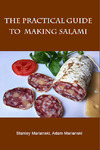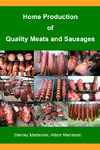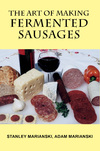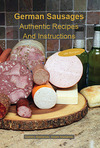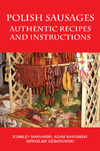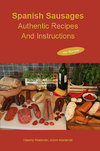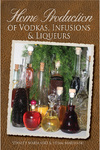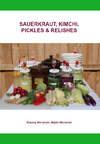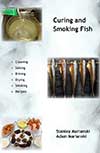Meats and Sausages
Gums in Sausage Manufacturing
Gelatin and starch are two known gums used in sausages. Gelatin is used in head cheeses and meat jellies; potato starch was often added to Russian sausages. Sausages can be made without gums if proper meat cuts are selected for particular sausages. If pork cuts with a lot of connective tissue are slow-cooked in a small amount of water, enough natural gelatin will be produced to produce a good textured head cheese. Ground meat should have enough binding power to bind meats in a regular sausage.
The difficulty arises when we decide to re-invent the typical sausage composition by eliminating fat and introducing filler material such as rice, flour, rusk, bread crumbs, oats, barley or buckwheat groats, semolina flour, textured vegetable protein (TVP) potatoes or beans. Such fillers can be added to many sausages to make them healthier. The fillers are rich in calories, have no cholesterol, and extend the value of the sausage. Vegetarian sausages do not employ meats at all; however, the ingredients must be bound together the same. We can use traditional solutions that call for soy proteins, egg whites, gelatin, flour, starch, or non-fat dry milk, but why not use gums? After all, this is what the food industry uses.
Gums, technically referred to as hydrocolloids originate from different sources. They can immobilize water and contribute to viscosity. Looking at processed food, you see all sorts of other gums like carrageenan, xanthan gum, cellulose gum, locust bean gum, gum arabic, agar, and more. The value of gums is not as a fat replacer but as a thickener that can combine with water and create a gel. Gums fulfill several functions in food products and they can:
- 1. Thicken things - ice cream, syrups.
- 2. Emulsify things - mixed liquids stay together without separating.
- 3. Change the texture - a gum will make something thicker.
- 4. Stabilize crystals - gum might help prevent sugar or ice from crystallizing.
- 5. Help reduce cooking loss, resulting in a higher yield and more succulent product.
The most popular gums:
- Agar
- Alginate
- Carrageenan
- Gellan Gum
- Gum Arabic
- Guar Gum
- Locust Bean Gum
- Konjac Gum
- Xantham Gum
While at first glimpse, such exotic names may discourage consumers from ever considering such products, the truth is that they are natural products we consume all the time. They are added to ice creams, puddings, sauces, and processed foods that require a creamy texture. Without gums sugar crystals will separate from ice cream. and many products would turn into a watery mess.
We take for granted that manufactured foods should always look good and taste well, but there is more to that than meets the eye. Food products are made in one location, then stored in a different one, and then transported many miles to a supermarket, where they will sit on a shelf for some time. Gums hold those products together. The reason that we dedicate so much space to gums is that they become more popular every day. Originally, only food technologists understood the subject, and they incorporated them into food products. Today, gums are commonly available and used in general cooking. Traditional jams were made by stirring fruit and sugar for hours until the mixture lost enough moisture to gel. Pectin shortens the process to minutes and the product looks better and has a better consistency.
A typical sausage maker does not need to use carrageenan, Konjac flour, or xanthan gum to give the sausage a superior texture. He can obtain great texture with meat scraps rich in connective tissue. Commercial producers need to use gums, as their products, like thinly sliced packaged ham, must hold their shape for a long time. A hobbyist can also use less expensive agents like gelatin, flour, eggs, or protein concentrate because the time between making the product and consumption is usually very short. A hobbyist making vegetarian sausages has a problem combining grains with vegetables without using meat rich in connective tissue. He can easily solve the problem by using gums.
Agar
Agar is made from the same family of red seaweeds as carrageenan. Agar is a natural vegetable gelatin counterpart. White and semi-translucent, it is sold in packages as washed and dried strips or in powdered form. Agar is approximately 80% fiber and is a popular product in Asia. It can be used as an addition or as a replacement for pectin in jams and marmalades, as a substitute for gelatin for its superior gelling properties, and as a strengthening ingredient in souffles and custards.
Alginate
Alginic acid, also called algin or alginate, is an anionic polysaccharide distributed widely in the cell walls of brown algae, where it, through binding water, forms a viscous gum. In extracted form, it absorbs water quickly; it is capable of absorbing 200-300 times its weight in water. The chemical compound sodium alginate is the sodium salt of alginic acid. Sodium alginate is a flavorless gum used to increase viscosity and to act as an emulsifier.
Carrageenan
Carrageenan is a natural extract from red seaweeds used in processed foods for stabilization, thickening, and gelation. During the heating process, carrageenan can absorb plenty of water and trap it inside. This contributes to a higher cooking yield and less purge during storage. About 0.01% (1 g per kg of meat) can increase the yield of the finished product by up to 8%. Usually, up to 1.0% (10 g/kg) of carrageenan is added to processed meats. Carrageenan does not disperse easily in cold water but will create a gel when the liquid is heated. It forms a solid gel during cooling. Carrageenan improves the sliceability of processed meats. The sausages with added carrageenan are firmer, and the casings peel off much easier. Be aware that adding more than 0.5% carrageenan may produce a tough gummy texture. Many vegans use carrageenan instead of gelatin since carrageenan is 100% vegetarian and gelatin is made from pork skins.
There are three types of carrageenan employed in the food industry:
- Kappa - meat products, very strong gel. It is currently the most used type of carrageenan in sausages.
- Iota - meat products, medium strong gel.
- Lambda - sauces and dressings. Does not gel.
Kappa carrageenan gels better in the presence of alkali agents such as potassium chloride (KCL). Enough potassium chloride is usually added to the carrageenan blend to create a strong gel. Potassium chloride is the same salt that is added to Morton’s Low Salt, at 50% level, thus the salt itself promotes the development of strong gel. In addition, milk protein is a strong promoter of carrageenan gels. Adding caseinate (milk protein) or non-fat dry milk will assist in the development of strong carrageenan gel. Kappa and Iota carrageenan are only partially cold water soluble and need to be heated for full activation. Lambda carrageenan is fully cold water soluble.
It is the gum of choice for making brine solutions pumped into whole meats. It binds water well and improves the sliceability of processed meats.
Gellan Gum
Gellan gum is a high molecular weight polysaccharide (i.e., complex sugar) gum produced as a fermentation product by a pure culture of the microbe Sphingomonas elodea. Gellan gum is a food additive that acts as a thickening or gelling agent and can produce gel textures in food products ranging from hard and brittle to fluid. Gellan is used in bakery fillings, confections, dairy products, dessert gels, frostings, glazes, jams and jellies, low-fat spreads, and other products.
Gum Arabic
Gum Arabic is the hardened sap of the Acacia Senegal tree, which is found in the swath of arid lands extending from Senegal on the west coast of Africa all the way to Pakistan and India. It’s a natural emulsifier, which means that it can keep together substances that normally would not mix well. Pharmaceutical companies use it to keep medicines from separating into their different ingredients; a dab of gum Arabic makes newspaper ink more cohesive and permanent. Coca-Cola uses gum Arabic to keep the sugar from precipitating to the bottom of its sodas. Gum Arabic is tasteless and edible. It has been extensively tested as a food additive and is considered one of the safest additives for human consumption.
Gum Arabic has many non-food uses as well. It is used in paints, inks, glues, printing, cosmetics, photography, incense cones, shoe polish, postage stamps, cigarette paper adhesive, and pyrotechnic operations. In beverages, gum Arabic helps citrus and other oil-based flavors remain evenly suspended in water. Gum Arabic can be completely dissolved in its volume of water. In confectionery, glazes, and artificial whipped creams, gum Arabic keeps flavor oils and fats uniformly distributed, retards the crystallization of sugar, thickens chewing gums and jellies, and gives soft candies a desirable mouth feel. In cough drops and lozenges, gum arabic soothes irritated mucous membranes. Many dry-packaged products, such as instant drinks, dessert mixes and soup bases, use it to enhance the shelf life of flavors. The gum is used in soft drink syrups, chocolate candies, gummy candies, and marshmallows. Like gelatin and carrageenan, gum Arabic can be used to bind food substances as well as to smoothen textures or to hold flavoring.
Guar Gum
Guar gum is made from the seeds of a plant that grows in India and Pakistan. When placed in contact with water, guar gum gels, even at low concentrations (1% to 2%). Guar gum has been used for centuries as a thickening agent for foods and pharmaceuticals.
Locust Bean Gum
Locust bean gum, also known as carob gum, carob bean gum, and carobin, is a galactomannan vegetable gum extracted from the seeds of the Carob tree, mostly found in the Mediterranean. Locust bean powder tastes similar to ground cocoa powder, but it contains less fat and calories than cocoa. It is dispersible in either hot or cold water. Locust bean gum is used in food products, cosmetics, and other products.
Note: guar gum and locust bean gum belong to a group of gums that are known as Galactomannans.
Both gums are excellent thickeners added to low-fat products to bind water. They are used in sausages to soften the texture and to facilitate stuffing. The clear advantage of both gums is that they can hold water at high temperatures, for example during the baking process, which results in a better product.
Konjac Gum
Konjac flour, also called konjac gum or konjac glucomannan, is produced from the konjac plant root and can form meltable or heat-stable gels. Konjac flour is rich in soluble fiber but does not contain starch or sugar, so it does not contain calories. It is also gluten-free. Its thickening power is 10 times greater than cornstarch. Konjac has the highest water-holding capacity of any soluble fiber, up to 100 times its water weight. One part of glucomannan can absorb 50 parts of liquid. About one teaspoon of konjac flour can gel about one cup of liquid, which may be water, meat stock, or wine. Konjac powder can be a thickener for smooth gravies, sauces, glazes, soups, stews, and casseroles. Konjac interacts synergistically with carrageenan, xanthan gum, locust bean gum. Konjac interacts with most starches, increasing viscosity and allowing texture to improve. As a gelling agent, konjac exhibits the unique ability to form thermo-reversible and thermo-irreversible gels under different conditions:
- Reversible gum- konjac mixed with xanthan gum.
- Non-reversible gum-when konjac heated at a pH of 9-10 (alkali added).
With a mild alkali such as calcium hydroxide, Konjac will set to a strong, elastic, thermo-irreversible gel. This gel will remain stable even when heated to 212° F (100° C) and above. Konjac will form a reversible gel when it is mixed with xanthan gum. Due to the thermo-irreversible property of the konjac gum, it has become popular to make a great variety of foods such as konjac cake, konjac noodles, and foods for vegetarians.
Preparing Konjac Gel
If konjac flour is added directly to food it may create lumps. Konjac powder thickens slowly when mixed with cold water, but quickly when heated. Mix konjac flour with cold water or other liquid first, stirring often until fully dissolved. Then, add it to a hot liquid or food that is being cooked. Konjac flour has no taste, so it inherits the product's flavor. Konjac flour can be mixed with other gums or starches. If you have not previously used konjac powder as a thickening agent, it is best to experiment with it by beginning with lesser amounts and adding as necessary until the desired consistency is reached. Adding 0.02-0.03% konjac to 1% xanthan gum will raise its viscosity by 2-3 times under heating. Konjac is usually added at 0.25-0.50%.
Konjac flour works like magic. Take 1 g of konjac, add 100 g of water, stir, and a gel is formed within seconds. Unli the gelatin, carrageenan, or starch, konjac does not need to be heated to gel. It is transparent and almost feels like fat. A good starting point is to mix 1 g of konjac with 1/2 cup (120 g) of water. Add the mixture to the ground meat and mix it with spices and you get a much better non-fat sausage. Konjac reacts synergistically with starches, making such a combination especially useful for reduced-fat products.
Konjac is used by people trying to lose weight as it provides the feeling of fullness. One teaspoon of konjac is mixed with 8 ounces of liquid and is drunk immediately as it will gel. For those reasons konjac gum should not be swallowed alone as it may draw saliva and moisture in our food tract, create gel and stoppage. It is safe when taken with large amounts of water. People on diets take konjac drinks three times a day.
Konjac flour is water-hungry and will bind all available free water to form a gel. This will make the texture of the sausage fine but hard. Adding 10-15% water to ground meat creates a better product. Even more water can be added when making emulsified sausages in a food processor.
Xanthan Gum
Xanthan gum is produced by fermentation of glucose, sucrose (corn sugar), or lactose by bacteria. During fermentation, a strain of Xanthomonas campestris bacteria turns sugar into a colorless slime called xanthan gum. Xanthan gum is most often found in salad dressings and sauces. It helps to prevent oil separation by stabilizing the emulsion, although it is not an emulsifier. Xanthan gum also helps suspend solid particles, such as spices. Also used in frozen foods and beverages, xanthan gum helps create a pleasant texture in many ice creams, along with guar gum and locust bean gum. Xanthan gum is soluble in cold water, but it should be well agitated to eliminate lumps.
Xanthan gum does not gelatinize when used alone, but it can form a gel at any pH when used with konjac gum. At a ratio of 3 (xanthan) : 2 (konjac), the strongest gel is obtained. The gel is thermo-reversible: it is in a solid state at temperatures below 40° C (104° F), but it will be in a semi-solid or liquid state at temperatures of 50° C (122° F) or above. It will resume the solid state when the temperature drops back to the ambient temperature <40° C (<122° F),
Preparing Xanthan Gel
Xanthan gum does not gel by itself, but combining 2 parts of konjac with 3 parts of xanthan creates a very strong gel. One gram of konjac plus 1.5 grams of xanthan will gel within seconds in one cup of water (236 g). Xanthan gum does not need to be heated, it gels with cold liquid. Xanthan can be mixed with an equal amount of guar gum, which is less expensive.
Gum Blends
It is often desirable to use a combination of gums to create a synergistic effect. Synergy means that a combined effect of two or more ingredients is greater than expected from the additive combination of each ingredient. In this case, the viscosity or gel strength will be greater if the following combinations are created:
- Xantham gum with guar gum.
- Xantham gum with bean gum.
- Konjac with carrageenan.
- Konjac with xanthan.
The above combinations may be used at a one-to-one ratio with each other.
The synergistic effect is also present when a gum is combined with starch.
- Konjac with starch.
- Carrageenan with starch.
Adding modified starch and gum to food produces a similar effect. However, modified starch is less expensive than gum. Adding starch to ground meat is a universally accepted method. On the other hand, 1 part of gum will produce a similar effect as 10 parts of starch, so the result balances out. Using gum is more crucial in fine products like yogurt or pie filling, where the change in flavor and mouthfeel is easy to notice.
Synergistic results of combining different gums are based on liquid gels. Those combinations may behave differently when added to ground meat. They will definitely bind water and create gels, but they may exhibit a weaker synergistic effect. The gums most often used in processed meats arecarrageenan, xanthan, and konjac.


